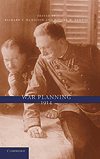
War Planning 1914, edited by Richard F. Hamilton and Holger H. Herwig, Cambridge University Press, New York, 2014, $29.99
To produce War Planning 1914, first published in 2009 and recently reissued in paperback, editors Richard Hamilton (emeritus professor of sociology and political science at Ohio State University) and Holger Herwig (research chair in military and strategic studies at Canada’s University of Calgary) coordinated with six contributors to examine the war plans of the six major European participants in World War I: Germany, France, Russia, Austria-Hungary, Italy and Great Britain. All had laid plans for war many years before July 28, 1914, and modified them periodically to a point each thought would bring it victory within months. Thus, France had Plan XVII, while Russia had Schedule 19A and Germany had Alfred von Schlieffen’s plan as modified by Helmuth von Moltke the Younger. All plans failed, and instead of bringing victory after a speedy advance, their mutual failures culminated in trench warfare on the Western Front and bloody stalemates on the Eastern Front and in the Italian Alps.
The editors and contributing authors offer many explanations for why all of the plans failed, but their general conclusion is that the political and military elites failed to coordinate their efforts to mobilize and integrate the manpower and industrial capacity necessary to achieve their goals. For that matter the politicians and generals themselves failed to cooperate sufficiently to assure the best prospect of success.
A case in point: The book explores Italy’s initial neutrality, which resulted in the once Triple Alliance starting the war as a dual one. As a consequence the Italian Third Army never reached the Rhine to support the German army in Lorraine as expected. That and the failure of Austro-Hungarian Chief of the General Staff and Field Marshal Franz Conrad von Hötzendorf to swiftly complete his forces’ occupation of Serbia in time to confront the Russian army were two factors in the Central Powers’ overall failure, leaving them in a state of strategic encirclement.
The essayists remind readers that the nations in question worked up their war plans at a time when there were neither computers nor particular masterminds to hone them. Communication was poor, and surviving documentation remains far from consistent, given, for example, that the manuscript section of the Russian State Library in Moscow does not permit ready access to the papers of General Mikhail V. Alekseyev, one of imperial Russia’s key war planners. Still, World War I enthusiasts and military analysts will find this book indispensable.
—Thomas Zacharis




